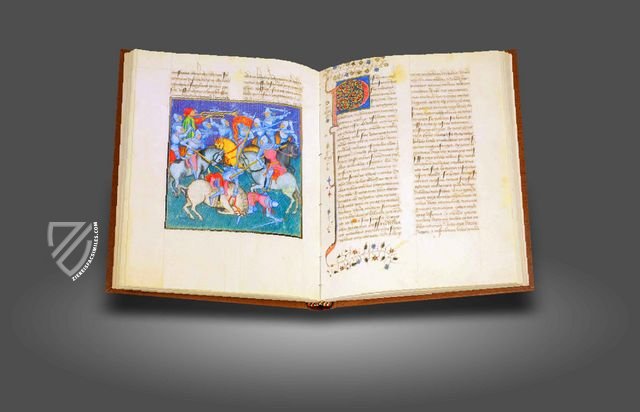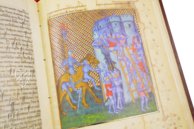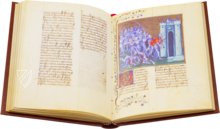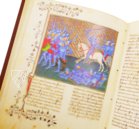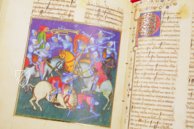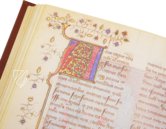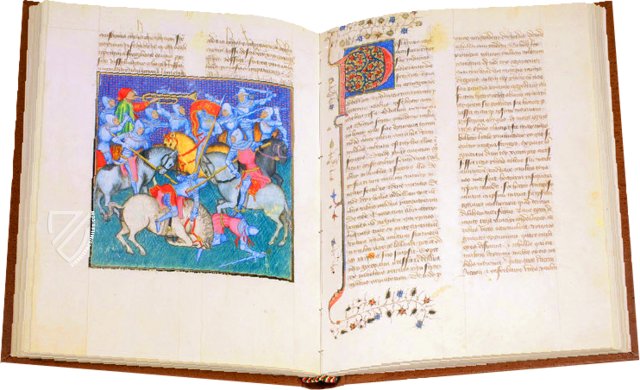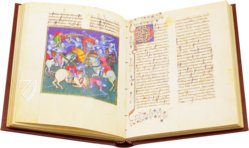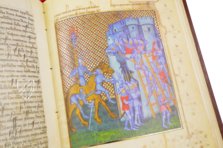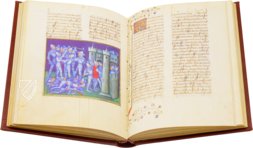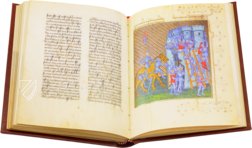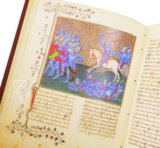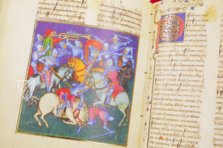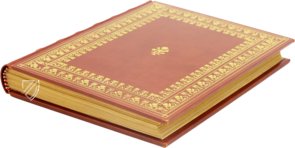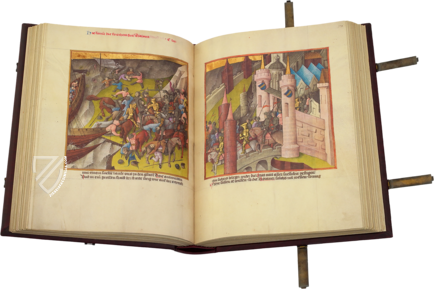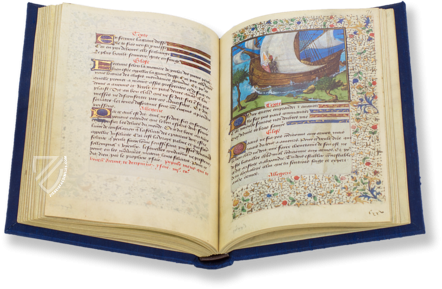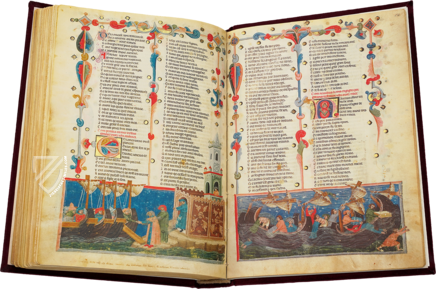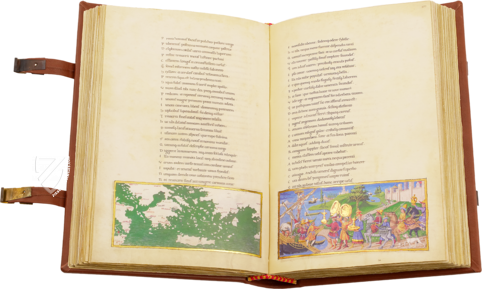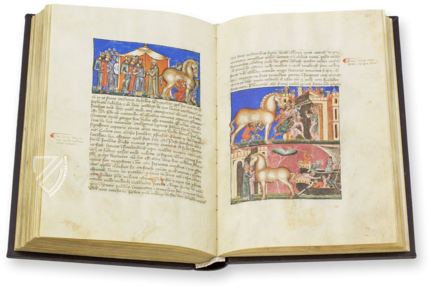History of the Destruction of Troy
(3,000€ - 7,000€)
The popular historical work by Guido de Columnis (around 1210 - around 1287) in a superbly illuminated 14th century French manuscript: this magnificent copy of the History of the Destruction of Troy, whose provenance is linked to great names in modern Russian history, is kept in the Russian National Library in St. Petersburg under the shelfmark Lat.F.v.IV.5. Two French miniaturists created the manuscript's impressive book decoration towards the end of the 14th century, which consists of 35 vibrantly colored miniatures – one miniature for each chapter. They are clearly influenced by the pioneering Italian art of the Quattrocento and yet also represent the tradition of the outstanding French book illumination of the time. Both the miniatures and the 35 wonderful decorated initials are lavishly adorned with golden details and make the important literary work of Guido de Columnis shine.
History of the Destruction of Troy
Waring hosts in luminous blue armor people the miniatures. Kings and protagonists are in bright colors, the people are represented as elegant gothic figures with elongated bodies, and there are decorative backgrounds with medieval peasants before a colorful raster. Gorgeous initials and exuberant bordures of fine foliage additionally characterize the elegant overall impression of the manuscript. Clearly oriented stylistically on the Italian art of the Quattrocento, the paintings are nonetheless rooted firmly in the tradition of the outstanding French illumination of that period. Two anonymous miniaturists took part in the furnishing of the manuscript. The battle scenes display an impressive variety of gestures and movements and so they are an expression of the great mastery of these artists!
The History of Troy According to Guido de Columnis
Manuscript Lat.F.v.IV.5 of the Russian National Library in St. Petersburg contains a total of 35 miniatures on 302 pages. These illustrate the famous text by Guido de Columnis about the destruction of Troy. Columnis composed his magnum opus in elegant Latin between 1270 and 1287 and organized it into 35 chapters. The text was adopted from Benoît de Sainte-Maure and enriched with his own ideas. Therefore, it contained moralizing notes, inter alia, to help Christians understand the story. At the time of its creation – the late 14th century – the St. Petersburg codex was extremely popular across all of Europe.
Desired by the Tsarina
Several famous names are bound-up with the St. Petersburg manuscript. The history of the codex up until the 18th century remains a mystery. It then first appeared in the possession of Jean-Louis Gaignant, a French book dealer. Catherine the Great was interested in buying Gaignant’s entire collection. However, the Trojan codex was acquired at the same time by the powerful Stroganov family. The treasured book finally reached the Russian National Library in 1889, where it is stored like a true gem today.
Codicology
- Alternative Titles
- Historia de la destrucción de Troya
Geschichte von der Zerstörung Trojas
Le Roman de Troie, de Benoit de Sainte-Maure - Size / Format
- 302 pages / 28.8 × 22.2 cm
- Origin
- France
- Date
- End of the 14th century
- Epochs
- Style
- Language
- Script
- Bastard Secretary
- Illustrations
- 35 miniatures with elaborately patterned backgrounds, 38 decorated initials with gold leaf and extensive floral curlicues
- Content
- Latin prose narrative of the Trojan legend
- Artist / School
- Guido della Colonna (ca. 1210 – ca. 1287) (author)
- Previous Owners
- Jean-Louis Gaignant
Stroganov family
History of the Destruction of Troy
The Trojan Horse
Painted mainly in beautiful shades of blue, this nocturnal scene shows what is probably one of the most famous parts of the legend of the Trojan War: while the besieged are lulled to safety, the soldiers quietly and secretly climb out of the large wooden horse in whose hollow interior they had hidden. They immediately attack the guard posts on the fortifications from inside the city. The fate of Troy and its inhabitants is now sealed.
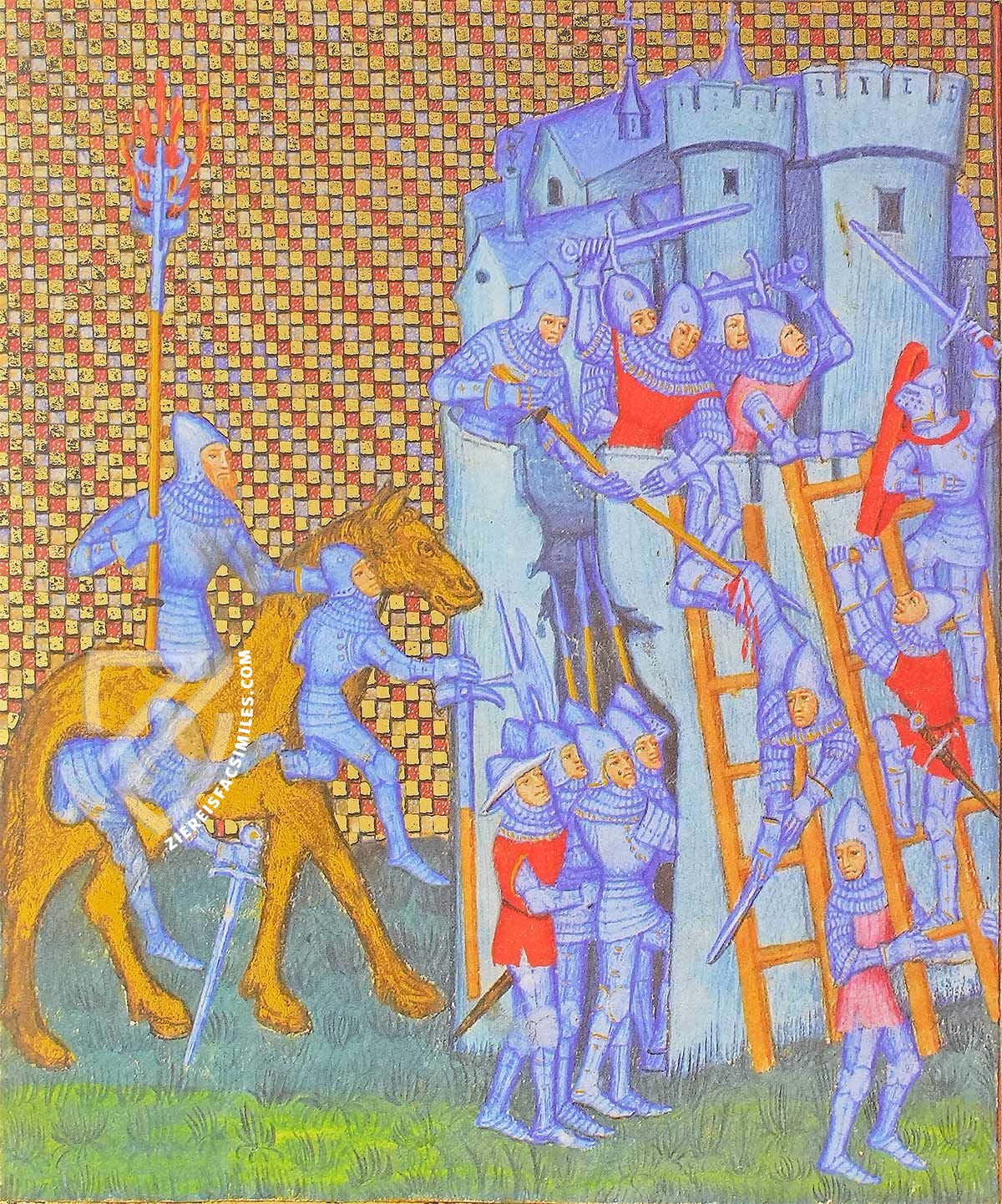
History of the Destruction of Troy
Guido de Columnis as Compiler
The first page of the manuscript shows a large, gold-decorated picture of the author, which introduces the reader to the work. It honors the author and also illustrates the lengthy process of creating the literary bestseller: Guido de Columnis is sitting on a typical scholar's chair, which is connected to a writing and reading desk. This is multi-leveled and thus offers a lot of shelf space for various books, the contents of which the author is apparently collating.
The method of compiling - the reading and selective merging of many existing texts - becomes tangible here. It was the standard method of literary creation throughout the Middle Ages and was highly regarded, as older writings were often accorded greater authority. Guido de Columnis also proceeded in this way, whereby he primarily based his work on Benoît de Sainte-Maure, but will also have read numerous other textual accounts of the Trojan legends.
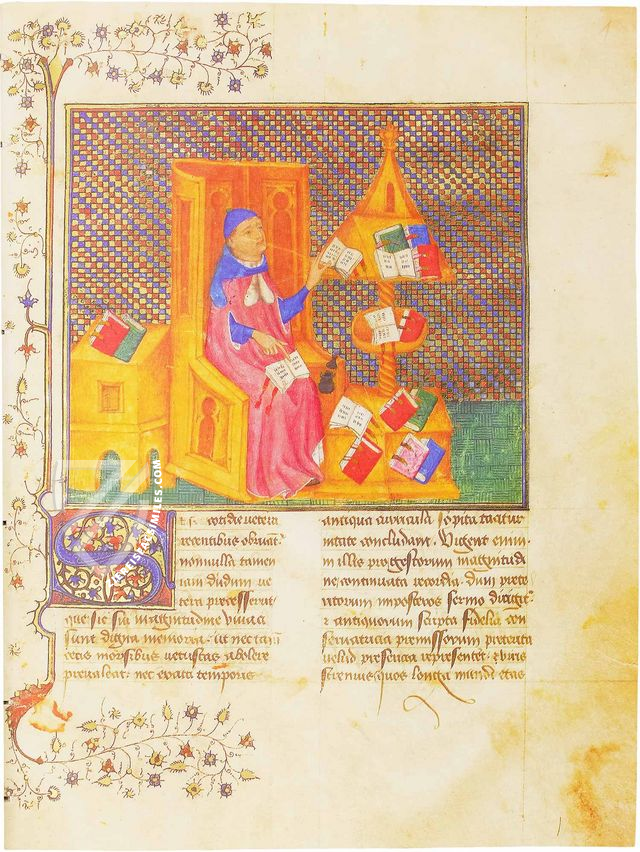
#1 Historia de la destrucción de Troya
(3,000€ - 7,000€)
- Treatises / Secular Books
- Apocalypses / Beatus
- Astronomy / Astrology
- Bestiaries
- Bibles / Gospels
- Chronicles / History / Law
- Geography / Maps
- Saints' Lives
- Islam / Oriental
- Judaism / Hebrew
- Single Leaf Collections
- Leonardo da Vinci
- Literature / Poetry
- Liturgical Manuscripts
- Medicine / Botany / Alchemy
- Music
- Mythology / Prophecies
- Psalters
- Other Religious Books
- Games / Hunting
- Private Devotion Books
- Other Genres
- Afghanistan
- Armenia
- Austria
- Belgium
- Belize
- Bosnia and Herzegovina
- China
- Colombia
- Costa Rica
- Croatia
- Cyprus
- Czech Republic
- Denmark
- Egypt
- El Salvador
- Ethiopia
- France
- Germany
- Greece
- Guatemala
- Honduras
- Hungary
- India
- Iran
- Iraq
- Israel
- Italy
- Japan
- Jordan
- Kazakhstan
- Kyrgyzstan
- Lebanon
- Liechtenstein
- Luxembourg
- Mexico
- Morocco
- Netherlands
- Palestine
- Panama
- Peru
- Poland
- Portugal
- Romania
- Russia
- Serbia
- Spain
- Sri Lanka
- Sweden
- Switzerland
- Syria
- Tajikistan
- Turkey
- Turkmenistan
- Ukraine
- United Kingdom
- United States
- Uzbekistan
- Vatican City
- A. Oosthoek, van Holkema & Warendorf
- Aboca Museum
- Ajuntament de Valencia
- Akademie Verlag
- Akademische Druck- u. Verlagsanstalt (ADEVA)
- Aldo Ausilio Editore - Bottega d’Erasmo
- Alecto Historical Editions
- Alkuin Verlag
- Almqvist & Wiksell
- Amilcare Pizzi
- Andreas & Andreas Verlagsbuchhandlung
- Archa 90
- Archiv Verlag
- Archivi Edizioni
- Arnold Verlag
- ARS
- Ars Magna
- ArtCodex
- AyN Ediciones
- Azimuth Editions
- Badenia Verlag
- Bärenreiter-Verlag
- Belser Verlag
- Belser Verlag / WK Wertkontor
- Benziger Verlag
- Bernardinum Wydawnictwo
- BiblioGemma
- Biblioteca Apostolica Vaticana (Vaticanstadt, Vaticanstadt)
- Bibliotheca Palatina Faksimile Verlag
- Bibliotheca Rara
- Boydell & Brewer
- Bramante Edizioni
- Bredius Genootschap
- Brepols Publishers
- British Library
- C. Weckesser
- Caixa Catalunya
- Canesi
- CAPSA, Ars Scriptoria
- Caratzas Brothers, Publishers
- Carus Verlag
- Casamassima Libri
- Centrum Cartographie Verlag GmbH
- Chavane Verlag
- Christian Brandstätter Verlag
- Circulo Cientifico
- Club Bibliófilo Versol
- Club du Livre
- CM Editores
- Collegium Graphicum
- Collezione Apocrifa Da Vinci
- Comissão Nacional para as Comemorações dos Descobrimentos Portugueses
- Coron Verlag
- Corvina
- CTHS
- D. S. Brewer
- Damon
- De Agostini/UTET
- De Nederlandsche Boekhandel
- De Schutter
- Deuschle & Stemmle
- Deutscher Verlag für Kunstwissenschaft
- DIAMM
- Droz
- E. Schreiber Graphische Kunstanstalten
- Ediciones Boreal
- Ediciones Grial
- Ediclube
- Edições Inapa
- Edilan
- Editalia
- Edition Deuschle
- Edition Georg Popp
- Edition Leipzig
- Edition Libri Illustri
- Editiones Reales Sitios S. L.
- Éditions de l'Oiseau Lyre
- Editions Medicina Rara
- Editorial Casariego
- Editorial Mintzoa
- Editrice Antenore
- Editrice Velar
- Edizioni Edison
- Egeria, S.L.
- Eikon Editores
- Electa
- Emery Walker Limited
- Enciclopèdia Catalana
- Eos-Verlag
- Ephesus Publishing
- Ernst Battenberg
- Eugrammia Press
- Extraordinary Editions
- Fackelverlag
- Facsimila Art & Edition
- Facsimile Editions Ltd.
- Facsimilia Art & Edition Ebert KG
- Faksimile Verlag
- Feuermann Verlag
- Folger Shakespeare Library
- Franco Cosimo Panini Editore
- Friedrich Wittig Verlag
- Fundación Hullera Vasco-Leonesa
- G. Braziller
- Gabriele Mazzotta Editore
- Gebr. Mann Verlag
- Gesellschaft für graphische Industrie
- Getty Research Institute
- Giovanni Domenico de Rossi
- Giunti Editore
- Graffiti
- Grafica European Center of Fine Arts
- Guido Pressler
- Guillermo Blazquez
- Gustav Kiepenheuer
- H. N. Abrams
- Harrassowitz
- Harvard University Press
- Helikon
- Hendrickson Publishers
- Henning Oppermann
- Herder Verlag
- Hes & De Graaf Publishers
- Hoepli
- Holbein-Verlag
- Houghton Library
- Hugo Schmidt Verlag
- Idion Verlag
- Il Bulino, edizioni d'arte
- ILte
- Imago
- Insel Verlag
- Insel-Verlag Anton Kippenberger
- Instituto de Estudios Altoaragoneses
- Instituto Nacional de Antropología e Historia
- Introligatornia Budnik Jerzy
- Istituto dell'Enciclopedia Italiana - Treccani
- Istituto Ellenico di Studi Bizantini e Postbizantini
- Istituto Geografico De Agostini
- Istituto Poligrafico e Zecca dello Stato
- Italarte Art Establishments
- Jan Thorbecke Verlag
- Johnson Reprint Corporation
- Josef Stocker
- Josef Stocker-Schmid
- Jugoslavija
- Karl W. Hiersemann
- Kasper Straube
- Kaydeda Ediciones
- Kindler Verlag / Coron Verlag
- Kodansha International Ltd.
- Konrad Kölbl Verlag
- Kurt Wolff Verlag
- La Liberia dello Stato
- La Linea Editrice
- La Meta Editore
- Lambert Schneider
- Landeskreditbank Baden-Württemberg
- Leo S. Olschki
- Les Incunables
- Liber Artis
- Library of Congress
- Libreria Musicale Italiana
- Lichtdruck
- Lito Immagine Editore
- Lumen Artis
- Lund Humphries
- M. Moleiro Editor
- Maison des Sciences de l'homme et de la société de Poitiers
- Manuscriptum
- Martinus Nijhoff
- Maruzen-Yushodo Co. Ltd.
- MASA
- Massada Publishers
- McGraw-Hill
- Metropolitan Museum of Art
- Militos
- Millennium Liber
- Müller & Schindler
- Nahar - Stavit
- Nahar and Steimatzky
- National Library of Wales
- Neri Pozza
- Nova Charta
- Oceanum Verlag
- Odeon
- Orbis Mediaevalis
- Orbis Pictus
- Österreichische Staatsdruckerei
- Oxford University Press
- Pageant Books
- Parzellers Buchverlag
- Patrimonio Ediciones
- Pattloch Verlag
- PIAF
- Pieper Verlag
- Plon-Nourrit et cie
- Poligrafiche Bolis
- Presses Universitaires de Strasbourg
- Prestel Verlag
- Princeton University Press
- Prisma Verlag
- Priuli & Verlucca, editori
- Pro Sport Verlag
- Propyläen Verlag
- Pytheas Books
- Quaternio Verlag Luzern
- Reales Sitios
- Recht-Verlag
- Reichert Verlag
- Reichsdruckerei
- Reprint Verlag
- Riehn & Reusch
- Roberto Vattori Editore
- Rosenkilde and Bagger
- Roxburghe Club
- Salerno Editrice
- Saltellus Press
- Sandoz
- Sarajevo Svjetlost
- Schöck ArtPrint Kft.
- Schulsinger Brothers
- Scolar Press
- Scrinium
- Scripta Maneant
- Scriptorium
- Shazar
- Siloé, arte y bibliofilia
- SISMEL - Edizioni del Galluzzo
- Sociedad Mexicana de Antropología
- Société des Bibliophiles & Iconophiles de Belgique
- Soncin Publishing
- Sorli Ediciones
- Stainer and Bell
- Studer
- Styria Verlag
- Sumptibus Pragopress
- Szegedi Tudomànyegyetem
- Taberna Libraria
- Tarshish Books
- Taschen
- Tempus Libri
- Testimonio Compañía Editorial
- Thames and Hudson
- The Clear Vue Publishing Partnership Limited
- The Facsimile Codex
- The Folio Society
- The Marquess of Normanby
- The Richard III and Yorkist History Trust
- Tip.Le.Co
- TouchArt
- TREC Publishing House
- TRI Publishing Co.
- Trident Editore
- Tuliba Collection
- Typis Regiae Officinae Polygraphicae
- Union Verlag Berlin
- Universidad de Granada
- University of California Press
- University of Chicago Press
- Urs Graf
- Vallecchi
- Van Wijnen
- VCH, Acta Humaniora
- VDI Verlag
- VEB Deutscher Verlag für Musik
- Verlag Anton Pustet / Andreas Verlag
- Verlag Bibliophile Drucke Josef Stocker
- Verlag der Münchner Drucke
- Verlag für Regionalgeschichte
- Verlag Styria
- Vicent Garcia Editores
- W. Turnowski Ltd.
- W. Turnowsky
- Waanders Printers
- Wiener Mechitharisten-Congregation (Wien, Österreich)
- Wissenschaftliche Buchgesellschaft
- Wissenschaftliche Verlagsgesellschaft
- Wydawnictwo Dolnoslaskie
- Xuntanza Editorial
- Zakład Narodowy
- Zollikofer AG

